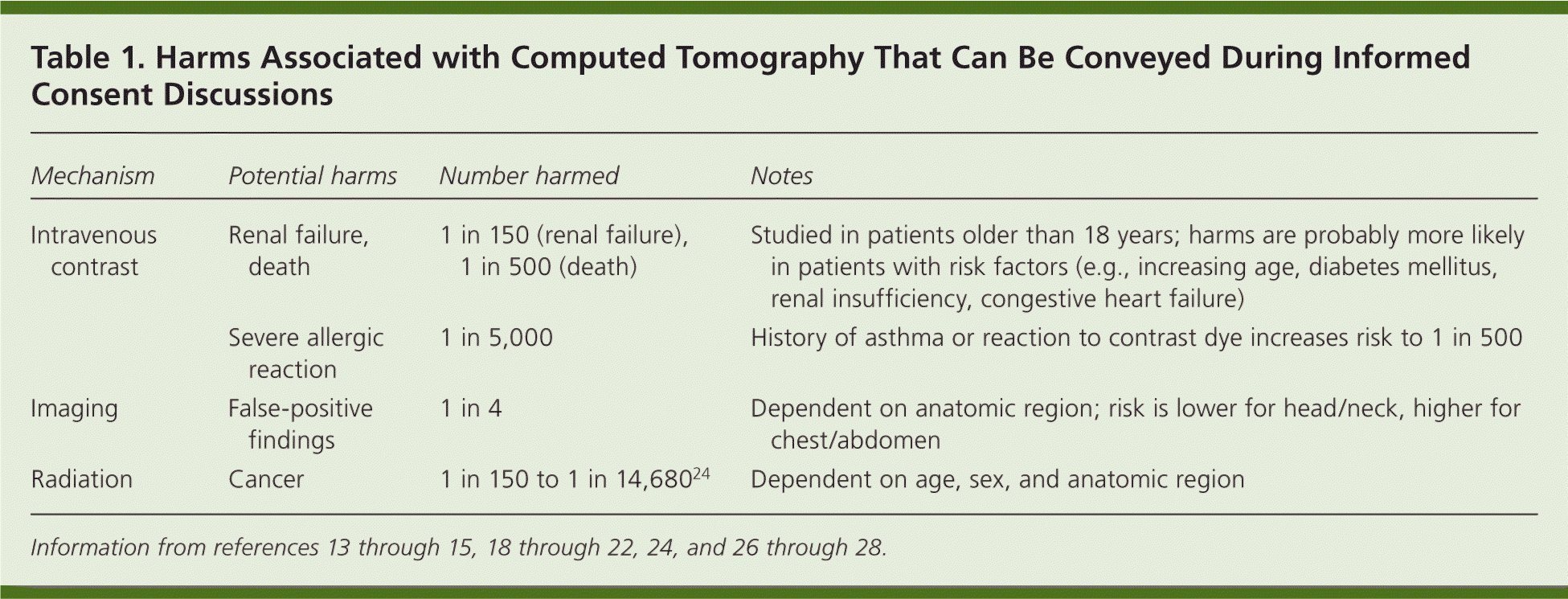
Am Fam Physician. 2013;88(5):294-296
Related article: When to Order Contrast-Enhanced CT
Author disclosure: No relevant financial affiliations.
Computed tomography (CT) is the predominant type of advanced imaging in the United States, with an estimated 72 million examinations completed in 2007.1 The use of CT imaging has risen dramatically in the past two decades,2,3 and there is substantial evidence that it is overused.4 In response to growing recognition of this problem, the American College of Radiology has published appropriateness criteria for imaging,5 and national radiology organizations have established campaigns to encourage physicians to “image wisely”6 and “image gently.”7
One concern underlying these initiatives is that the harms and risks of CT have been underestimated and poorly understood,8–10 and are not often discussed with patients.11 In this issue of American Family Physician, Drs. Rawson and Pelletier discuss the harms associated with intravenous contrast, including allergic reactions and renal injury.12 We outline two additional harms, radiation exposure and false-positive incidental findings, and quantify all four to better inform decisions about CT imaging. These harms should be balanced with the potential diagnostic benefits.
One study found the risk of severe allergic reactions with nonionic contrast (more commonly used than ionic contrast in the United States13) to be one in 7,400 patients exposed,14 whereas other studies have suggested that severe anaphylactic reactions occur in one in 2,500.13–15 Thus, the risk of severe reactions may be reasonably estimated at one in 5,000, although a history of asthma or reactions to contrast agents increases the risk to one in 500.13
Intravenous contrast agents are known precipitants of nephropathy.16 Renal failure and death from renal failure are patient-oriented outcome measures, whereas contrast-induced nephropathy is not. Data on the risk of hospitalized patients undergoing coronary angiography suggest that the rate of acute renal failure (requiring dialysis) is 0.4% to 1.1% (one in 250 to one in 90), with associated mortality of 0.07% to 0.2% (one in 1,430 to one in 500).17 In the only high-quality study with adequate follow-up, 1% of emergency department out-patients older than 18 years who underwent CT with intravenous contrast experienced renal failure, and 0.6% died.18–20 These numbers suggest a roughly 1% rate of renal failure, with approximately one-half of cases being fatal.
Radiation from imaging tests is linked to incidental cancer.4,21,22 The Institute of Medicine concluded that exposure to radiation is one of the most important risk factors for breast cancer.23 A table showing the effective radiation doses associated with various types of CT imaging and corresponding attributable lifetime cancer risks is available at http://archinte.jamanetwork.com/article.aspx?articleid=415384.24 As an example, it is estimated that one in 500 women 20 years of age who undergo unenhanced CT of the abdomen and pelvis will develop cancer in her lifetime because of the imaging study, and one-half of these cases will be fatal.21,22,24
Another harm resulting from CT imaging is incidental findings that lead to a costly and potentially harmful cascade of further testing with no medical benefit.4,25 The rate varies by type of imaging. Chest CT reveals incidental findings that require further evaluation in up to 41.5% of tests.26 After two scans for lung cancer screening, one in three patients had a false-positive incidental finding, and one in 15 underwent surgical or invasive procedures.27 Among trauma patients, approximately 30% of abdominal CT scans and 6% of head CT scans demonstrate incidental findings that lead to a recommendation for follow-up.28 Overall, a reasonable estimate is that one in four CT examinations, particularly those of the abdomen and chest, will lead to a false-positive finding.
Table 1 outlines the four major potential harms that should factor into physician and patient decision making about CT imaging.13–15,18–22,24,26–28 The degree to which these harms are discussed will depend on several factors. First, the risk of harm should meet the “prudent person standard,” meaning that a reasonable person would want to know. Second, the risk should be greater than that experienced in routine daily living.29 Third, the potential benefit should be compared with the potential harm. For a young woman with pleuritic chest pain and no risk factors for venous thromboembolism, the one-in-330 lifetime risk of cancer associated with chest CT, when added to the risks of a severe allergic reaction and renal failure from the contrast agent, may be greater than the potential benefit of ruling out pulmonary embolus.19,30 Conversely, a 60-year-old woman with significant head trauma and unilateral weakness has a substantial potential for benefit from CT, and the one-in-10,000 attributable cancer risk is of questionable relevance.

| Mechanism | Potential harms | Number harmed | Notes |
|---|---|---|---|
| Intravenous contrast | Renal failure, death | 1 in 150 (renal failure), 1 in 500 (death) | Studied in patients older than 18 years; harms are probably more likely in patients with risk factors (e.g., increasing age, diabetes mellitus, renal insufficiency, congestive heart failure) |
| Severe allergic reaction | 1 in 5,000 | History of asthma or reaction to contrast dye increases risk to 1 in 500 | |
| Imaging | False-positive findings | 1 in 4 | Dependent on anatomic region; risk is lower for head/neck, higher for chest/abdomen |
| Radiation | Cancer | 1 in 150 to 1 in 14,68024 | Dependent on age, sex, and anatomic region |
With CT imaging, we seek to understand patients' pathologies, to reduce uncertainty, and ultimately to heal. However, in our zeal to accomplish these goals, we have been less attentive to the Hippocratic ideal: primum non nocere. With shared decision making, an understanding of benefits and harms, and the informed use of technologies, this ideal is well within reach.
